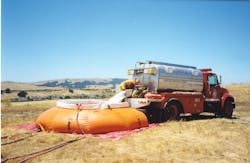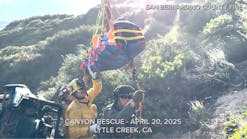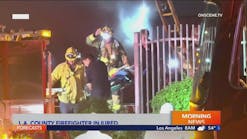Successful Tender Operations Keep Water Flowing on the Fireground
As has been described many times, the primary fire extinguishing agent employed by the fire service is water. Generally speaking, water is abundant and is relatively inexpensive.
Urban fire agencies employ various evolutions in order to achieve maximum effectiveness from their water supply infrastructures. Most rural fire companies are proficient in transporting large volumes of water to serious fires that occur in locations distant from municipal water systems. However, the growing contemporary firescape involves increasing numbers of critical incidents where urban companies are deployed to assist with rural fire operations or where serious wildfires threaten wildland/urban interface (WUI) zones and need to be controlled prior to becoming immediate threats to structures and other valuable property.
Virtually every fire is controllable at some point. Delayed detection, insufficient resources, flawed tactics and the inability to sustain fire attack hose streams can create opportunities where circumstances can drive such fires beyond the ability for immediate control. Such failures are particularly problematic when fuel and weather conditions are conducive to rapid fire expansion.
Many contributing factors affecting the control of potentially serious fires fall outside most fire agencies’ abilities to significantly influence, and to its credit the fire service has generally been effective in addressing many of those elements that it can control. However, in analyzing troublesome fires, it is my conclusion that additional thought should be given to providing effective mobile water supply, particularly in rural and WUI environments.
When companies lose water
I consider any operation where companies have managed to establish a reasonably reliable wet line around a threatening fire and then subsequently lose control when they run low on water as being a strategic failure. Particularly when extended hoselays are deployed, crews should not be left at the end of long lines without some safety reserve of water being maintained in the engines supplying those lines. Thus as companies begin to reach that critical low level of water, either the company must be resupplied, another company with adequate water must take over pumping the working lines, or personnel will have to take up and potentially lose control of their portions of the fire line.
In listening to the radio traffic of various fire agencies, all too frequently someone on the scene reports concerns that companies are starting to run low on water. That message is usually followed by requests by the Incident Commander for more tactical resources and for water tenders. In labor-intensive fire control operations the call for more engines to augment on-scene water could also provide additional personnel to assist or relieve initial attack companies. However, in circumstances where the objective simply involves preventing attack companies from running out of water, the deployment of additional engines due to a lack of on-scene water tenders can create an unnecessary drawdown of the region’s remaining engine companies.
Water tenders are typically larger, less nimble apparatus. They should be driven more carefully and thus usually involve longer response times than that of engines based at the same locations. There have been an alarming number of road accidents involving water tenders in proportion to the small percentage that they make up of the national fire service fleet. Delayed responses of water tenders, particularly when tender drivers hear at-scene companies calling for water, can create a great deal of pressure on those drivers to respond rapidly to the scene. Such scenarios run counter to what we should be adopting as our safety culture.
The mobilization of water tenders should be part of an orderly, systematic process rather than part of an urgent, catch-up operation. Resources that turn out not to be needed can always be returned. Furthermore, a water tender that is unused but held at the Staging Area can be utilized during demobilization to top off engine companies as they are being released, returning them to full service immediately upon being detached from the incident.
Much has been achieved in improving the interoperability of communications, equipment, and municipal water supply systems. However some interoperability issues still remain with respect to the utilization of water tenders provided by different agencies at large incidents, particularly when portable tanks are deployed. While there are various options available to work around such difficulties, they are generally less efficient and much more time consuming than the ability to "quick dump" into another agency’s tank and get back on the road to resupply. Not only does the lack of ability to quick dump markedly increase the round trip time of the tender so affected (total time to deliver its load, leave to refill and return,) but its increased time at the portable tank could delay the next tender in the shuttle from delivering its load on time and thus degrade the entire shuttle operation.
Interoperability of all area water tenders with the various types of portable tanks that would be deployed should be evaluated so that problems are identified and logged so that incoming water tenders can be given assignments for which they are best suited. Furthermore, as water tenders are a type of resource for which agencies often rely on each other for augmentation, it only makes sense for all affected agencies to voluntarily agree on basic design standards to prevent anomalies during critical fire control operations.
Proper tender utilization
The circumstances surrounding each incident may dictate different tactical evolutions.
For relatively simple fires, a nurse tender operation may be appropriate. In this evolution the tender simply continuously supplies an engine operating at the scene and prevents it from running out of water. Nurse tender operations are easy to establish but they have a significant weakness. In the event the tender’s additional water is insufficient to completely extinguish the fire, the now-empty tender will have to depart for more water leaving the engine company unreinforced or an additional tender must be summoned. Due consideration must be given to fire flow and total anticipated water usage before committing to a nurse tender operation.
At wildland fires there may be opportunities for water tenders to operate on the move and top off engines that are operating alongside streets and improved fire roads, alleviating the need for companies to take up to resupply with water. Consideration must be made to determine the abilities of various tenders to navigate such roads and also that they don’t become stuck in a crowd of engines or on some winding, dead-end lane.
Many modern water tenders can be used tactically to directly supply critical incident hoselays. When water shuttles are not required or sufficient additional tenders are available, a tender could be assigned to pump a critical hoseline such as found in a progressive hoselay containing several branch lines, and thus eliminate an anticipated resupply problem. However as with the nurse tender evolution, consideration must be given to the potential for the tender to eventually run low and need to resupply itself.
In general, the most effective use of water tenders during complex incidents involves the use of portable tanks and water tender shuttles. Portable tanks should be placed in locations that are most strategically beneficial for access, traffic circulation and to facilitate rapid dumping. Also to be considered is whether the water would be used by ground units, helicopter buckets or a combination thereof. When air resources are involved, location and the ability to keep the portable tank full can be critical considerations.
Calculating needed resources
Some simple arithmetic should be applied to calculate the number of water tenders likely required in order to conduct a successful shuttle operation. A roundtrip involves the total (in minutes) of dump time, plus travel time to refill, time to refill and time to return loaded to the portable tank. The objective is to provide enough tenders to at least equal the rate of fireground water consumption. Roundtrip time calculations should be based on the tender requiring the longest dump time as that unit will set the pace of the entire operation.
For example, let’s use round figures of 200 gpm of fireground water use and 2,000-gallon water tenders. The least efficient tender can dump its load in four minutes. We’ll assume that the travel time between the portable tank and water source is 8 minutes empty and 10 minutes loaded. Fill time for the tenders at the water source is 5 minutes. In this hypothetical scenario the time required for each water tender to complete a roundtrip is about 27 minutes, not counting any delays. In 27 minutes, 5,400 gallons of water would be consumed at the fireground. Therefore a minimum of three 2,000 gallon water tenders would be required to produce a reliably consistent water supply.
Getting the water out
In most circumstances, the most efficient way to get water from portable tanks involves drafting. Many apparatus operators are wary about drafting, however, it actually is a relatively simple process provided the fire apparatus is in good working order and the suction layout is free of vacuum leaks. With pumpkin or burrito type tanks, the suction strainer can be placed under the lip of the tank. With rigid portable tanks, a beach ball can be tossed into the water to reduce air intake when the water whirlpools above the suction strainer. With rigid tanks, some means may be required to protect drafting hose where it passes over the top edge of the tank.
Depending on available resources, it may be more efficient to assign an engine to maintain a draft at a tank and resupply mobile units as they come in rather than have each engine coming to refill and establish its own draft supply. Floating pumps are also often used in portable tanks to refill mobile apparatus, however their discharge rates are limited and that could be problematic if many mobile engines need to resupply and return to fire lines.
One use of the portable tank involves deployment at a location where multiple attack lines can be supplied by a drafting engine or multiple floating pumps. However, operations can get tricky when rapidly dumping water into a tank where floating pumps are actively pumping. A tarp or salvage cover may be required as a baffle to prevent the pumps from becoming drenched and stalling out.
Overreliance on municipal water systems
Municipal water supply systems typically have more limited capabilities at higher elevations and as the distance increases between municipal storage facilities to the point of use. Reductions in capabilities are even more dramatic in hillside neighborhoods that have long, often dead-end water mains. Furthermore, many residents tend to water down their properties, leave sprinklers on when told to evacuate, and take other actions that often have no beneficial effect but can reduce municipal water pressure and deplete storage. It is important to recognize the potential limitations of municipal water systems under such dynamic conditions and plan in advance for the augmentation of these water supplies.
Apparatus specification considerations
There are several issues to consider when specifying building a water tender. Agencies and companies operating on tight budgets may consider converting fuel tankers for water tender service. Water weighs over two pounds per gallon more than gasoline so a converted apparatus carrying 2,000 gallons of water will be over 4,000 pounds heavier than when it carried fuel. It is important to consider these weight differences when determining what additional equipment can be carried while keeping within the vehicle’s gross weight rating. Brake components may need upgrading to ensure control of a now-heavier vehicle.
Rectangular tanks are more compact than oval tanks of equal capacity and allow for more compact apparatus dimensions. The cost of a shorter, more maneuverable vehicle involves a higher center of gravity that will have an impact on stability in certain circumstances. Given the propensity of water tenders to be involved in vehicle accidents, anticipated terrain and road conditions should be considered when weighing the value of maneuverability against stability and control.
When determining the numbers, sizes and placement of dump valves, consideration should be made with respect not only to dumping efficiency but to the safety of personnel during roadside operations. Square dump outlets are more efficient than round outlets of similar size. Furthermore, square dump outlets can come in sizes up to 12 inches, facilitating very rapid offloading.
Round dump outlets have other operational advantages. Short lengths of large diameter hose can be more easily attached to round outlets in order to offload water in awkward situations where a direct dump would be difficult. Dumping efficiency can be improved, oftentimes producing three times the flow rate, when a jet dump system is installed. As the performance characteristics of various jet dump designs can vary significantly, manufacturer’s specifications should be carefully evaluated to determine whether local operations may be best served by a jet system, and by what type of jet design.
Another consideration involves the likely service objectives of the water tender during its anticipated service life. Is it going to be strictly a support resource to deliver water for other companies? Might it be used tactically to directly pump hoselines in operations that require more water than would be carried by engine companies but would not likely require shuttle operations? If the tender would likely be employed as a tactical resource, would it be self-contained (requiring more careful gross weight calculations when expected to carry additional equipment) or would it be operated as a two-piece company with an engine or hose wagon? Such evaluations should focus forward so that the tender’s design doesn’t become obsolete during its service life.
The water supply officer or group
Much has been written in NIOSH and USFA investigative reports as well in a number of well-reasoned articles about the perils of assigning too many responsibilities to Incident Commanders. Such overburdens have contributed to delays in recognizing critical changing conditions that have, in an alarming number of instances, led to loss of fire control and even firefighter and citizen fatalities. Except during relatively simple operations, establishing and maintaining effective and responsive water supply operations warrants creating a distinctive functional group command.
This functional group, operating under the Operations Section Chief, can address multiple issues including but not limited to:
- Estimating anticipated water usage.
- Determining locations and capabilities of available resources.
- Determining the most effective water supply incident support strategies and tactics.
- Determining the most advantageous locations to deploy portable tanks.
- Developing an effective traffic circulation plan, monitoring water consumption.
- Ensuring the continuous operational efficiency of water resupply operations.
- Determining if water shuttles are keeping pace with consumption (whether additional resources are needed or conversely can be released.)
- Exchanging information with command staff relevant to changing incident circumstances, priorities, tactics and support needs.
To be consistently effective and to preserve operational safety, more supervision is often warranted than simply setting water supply operations in motion and letting things work out for themselves. Except in areas where various entities train together religiously, and even in those well-practiced areas when unusual events occur, the most prudent approach is to assign a qualified individual whose sole assignment is to ensure that the water supply needs of working companies are met efficiently, safely and on time.
While most incidents may not actually require the undistracted efforts of a dedicated Water Supply Group Supervisor, it is best to establish a familiar protocol during non-critical emergencies to help ensure that those decisions made during high-pressure situations are predictable and effective.
Multi-company training
We constantly practice advancing hoselines, placing ladders and similar company-level evolutions. While some areas are active in conducting intercompany and/or interagency water supply drills, in many others the more advanced operations are relegated to theory and “show and tell.”
Developing effective intercompany and/or interagency water supply evolutions can be produced through well-designed tabletop exercises followed by practical multi-company practice. A reasonable standard to achieve is the ISO’s two-hour Water Supply Delivery Test. The water supply component can be coupled with other engine company evolutions to maximize the effectiveness of the day’s training. Company personnel will come away with a better understanding of their respective roles in these operations while command staff can observe and determine the times necessary to complete the various elements involved in establishing and maintaining an effective, continuous rural water supply.
While this article is not intended to address all the various water supply issues in detail, it will hopefully spark some thoughtful proactive consideration of this issue. Besides, it’s far more comfortable to be prepared when commanding a challenging fire than to have to attempt to mitigate critical operational flaws on the fly.
WILLIS LAMM is the retired Water Supply Officer from the Moraga-Orinda, CA, Fire District, a former member of the American Water Works Association Hydrant Standards Committee, and a consultant on fire service and water supply issues.






